Maine Garlic Pest Field Notebook
By Steven B. Johnson, Extension Crops Specialist, and David Fuller, Extension Agriculture and Non-Timber Forest Products Professional, University of Maine Cooperative Extension
Reviewed by David Lambert, Plant Pathologist, University of Maine
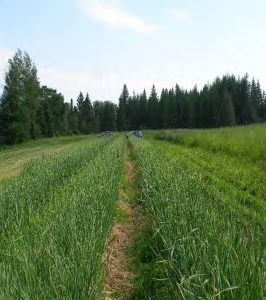
Maine Garlic Pest Field Notebook (PDF)
All photos by authors. Updated 2022.
Table of Contents
- Introduction
- White Rot
- Blue Mold
- Botrytis
- Black Mold
- Embellisia
- Rust
- Garlic Bloat
- Bulb Mites
- Leek Moth
- Wireworm
Introduction
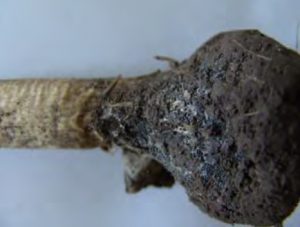
Garlic is a member of the Allium family, which includes onions, chives, and leeks. Garlic originated in central Asia, and has been grown for 5,000 years in Egypt and India. Garlic is widely grown in Maine, and has become an economically important crop to many farms.
This guide can help Maine farmers identify and understand how to manage garlic pest issues on their farm and help improve farm profitability.
White Rot
White rot is caused by the fungus Sclerotium cepivorum. It is the most destructive fungal disease of garlic. The buildup and spread of white rot to uninfested areas is a serious concern, as white rot can render a field unusable for garlic or other Allium species for as long as 40 years, even without an Allium host. The pathogen survives in the soil as sclerotia, which are dormant fungal structures.
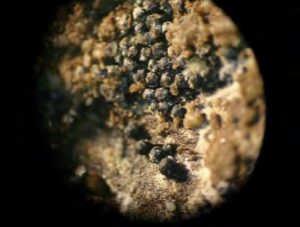
Sclerotia will lay dormant until root exudates unique to Allium species stimulate germination. Initial signs of white rot are yellowing lower leaves, or stunted plants, followed by plant death. The affected areas in the field will continue to enlarge as the season progresses. Tiny black sclerotia form on the bulb. Plant material, water, soil, equipment, or human movement can spread sclerotia.
White rot management focuses on not introducing Sclerotium cepivorum into the field. Once white rot is present in a field, little can be done other than to cease planting Allium crops in the field. Crop rotation is of limited use in disease control, owing to the long persistence of white rot sclerotia in the soil.
Blue Mold
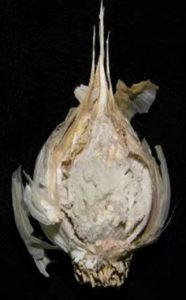
Penicillium hirsutum.
Blue mold is caused by Penicillium hirsutum. While the pathogen can cause poor plant stands, Penicillium decay of stored bulbs is more common, and more economically devastating. Advanced stages of bulb and clove rot have a characteristic mass of blue to blue-gray growth.
Spores from diseased bulbs can spread and contaminate otherwise healthy bulbs and cloves during cracking of bulbs for planting. Any wounds provide entry points. The pathogen survives in and on infected bulbs; it does not survive well in the soil.
Field symptoms may include yellowed and stunted plants; advanced symptoms appear as masses of blue or blue-gray fungal growth at the base or sides of the bulb.
Avoid trimming the tops or roots too close to cloves. Proper drying and curing of bulbs will reduce entry points. Care in handling bulbs during cracking will reduce wounding, reducing entry points for the pathogen. Practice crop rotation, in space as well as time, to effectively reduce the pathogen.
Botrytis
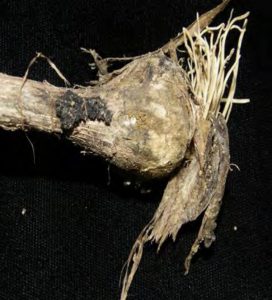
Botrytis porri.
Botrytis porri is the fungal pathogen that causes neck rot in garlic. It is spread rapidly through the planting of infected garlic cloves.
Botrytis porri is limited to the Allium family. The disease can cause considerable damage to garlic under wet conditions where the bulbs may be crusted with sclerotia. These black sclerotia, as large as three-quarters of an inch but typically one-quarter inch in diameter, serve as inoculum for following seasons.
Infected plants are stunted, with water-soaked lesions on the neck at the soil line, and later covered with sclerotia.
Infected plants are stunted, with water-soaked lesions on the neck at the soil line, and later covered with sclerotia.Warm, wet conditions favor infection and subsequent disease development. Excessive water from irrigation or rain is highly conductive to the disease.
Warm, wet conditions favor infection and subsequent disease development. Excessive water from irrigation or rain is highly conductive to the disease.High humidity and wet foliage with prolonged soil wetness will promote Botrytis
High humidity and wet foliage with prolonged soil wetness will promote Botrytis porri infection and disease development. Carefully inspect and cull infected bulbs. Properly cure remaining garlic bulbs with good air movement.
Crop rotations in both time and space are crucial in maintaining a neck-rot-free crop of garlic.
Black Mold

Aspergillus niger.
Black mold, caused by the fungal pathogen Aspergillus niger, occurs in the field, during transit, and during storage. The fungus grows on dead tissue and is a common inhabitant of the soil; spores are also common in the air. Bulb infection usually occurs through injured tissues in the neck or wounds on roots, basal stem plates, or outer clove. Uninjured bulbs are seldom infected.
The disease is favored by warm temperatures or warm storage conditions. Infected bulbs display a black discoloration at the neck or in bruised areas, lesions on outer cloves and black streaks beneath clove wrappers. As the disease develops, the entire bulb may appear black and shriveled as all cloves become infected. If soft rot bacteria invade, the bulbs may develop a watery rot. Some bulbs will show no external symptoms, but when the bulb is cut open, cloves may be gray to black.
Embellisia
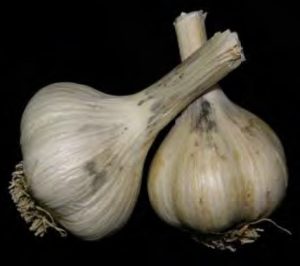
Embellisia skin blotch is caused by Embellisia allii, a fungal pathogen. The pathogen is widely distributed in Maine. It is typically a cosmetic issue for garlic vendors, and is easily managed.
Embellisia allii overwinters in plant debris, infested soil, diseased bulbs and cloves. The disease is a greater problem in wet years, or in years with poor drying conditions after harvest. The disease can also be a problem if garlic is stored under moist conditions.Symptoms start as small water-soaked lesions on the bulbs and develop into brown-to-black lesions, generally underneath the bulb epidermis. Generally, Embellisia
Symptoms start as small water-soaked lesions on the bulbs and develop into brown-to-black lesions, generally underneath the bulb epidermis. Generally, Embellisia allii causes cosmetic damage on the bulb only. On occasion, the disease may progress into cankers on the cloves.Crop rotation is of limited value as a management tool for disease control. Proper drying conditions and storage conditions with relative humidity less than 70 percent will greatly reduce the potential for the disease. Sorting and removal of diseased bulbs is recommended. When the disease is present, removing the affected outer wrappers on garlic bulbs is usually sufficient to make the crop marketable.
Crop rotation is of limited value as a management tool for disease control. Proper drying conditions and storage conditions with relative humidity less than 70 percent will greatly reduce the potential for the disease. Sorting and removal of diseased bulbs is recommended. When the disease is present, removing the affected outer wrappers on garlic bulbs is usually sufficient to make the crop marketable.
Rust
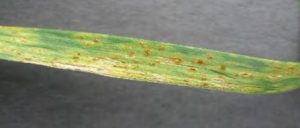
Garlic rust is caused by the fungus Puccinia allii. Garlic rust is a sporadic disease that generally causes limited economic damage. The fungus probably overwinters on infected crop residue. Two distinct types of Puccinia allii are known: “garlic type” and “leek type.” Leeks, shallots, and elephant garlic have not been found to be susceptible to rust strains present in North America.
Early symptoms are small white-toyellow spots or flecks on leaves, which turn yellow to orange as different stages of the fungus develop in the leaf tissue. The yellow-to-orange spots become pustules (uredinia) containing spores that are released in the repeating stage of the fungus, spreading the pathogen to other garlic leaves in the same season. The spores are disseminated by wind and thereby spread long distances.
No rust-resistant varieties of garlic are known.
Garlic Bloat
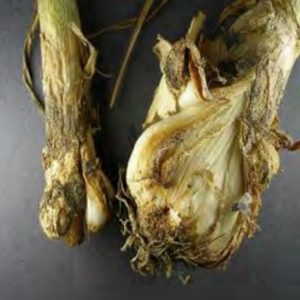
Ditylenchus dipsaci.
Bloat is caused by Ditylenchus dipsaci, a destructive nematode of many crops, but especially Allium species like garlic and onions.
Cool, moist conditions favor invasions of plants by this nematode. The nematodes can penetrate through stomata, cracks, or leaf axils.The bloat nematode moves limited distances on its own; most often it is introduced to a field by planting
The bloat nematode moves limited distances on its own; most often it is introduced to a field by planting infested cloves.Symptoms include leaf yellowing and premature death. Entire cloves or bulbs will become shrunken and soft, darken, and eventually decay. The absence of roots is a symptom of infestation. Advanced symptoms include distinct swellings, or “bloat,” as well as underdeveloped or deformed bulbs.
Symptoms include leaf yellowing and premature death. Entire cloves or bulbs will become shrunken and soft, darken, and eventually decay. The absence of roots is a symptom of infestation. Advanced symptoms include distinct swellings, or “bloat,” as well as underdeveloped or deformed bulbs.Bloat nematode is introduced and perpetuated primarily by planting seed that is infested with the nematode. Do not plant any garlic from a crop that has bloat. If bloat nematode has been confirmed in a field, do not replant any garlic from that field. Bulbs from an infested field may appear symptomless, but could harbor low levels of bloat nematodes and will perpetuate the issue.
Bloat nematode is introduced and perpetuated primarily by planting seed that is infested with the nematode. Do not plant any garlic from a crop that has bloat. If bloat nematode has been confirmed in a field, do not replant any garlic from that field. Bulbs from an infested field may appear symptomless, but could harbor low levels of bloat nematodes and will perpetuate the issue.
Bulb Mites
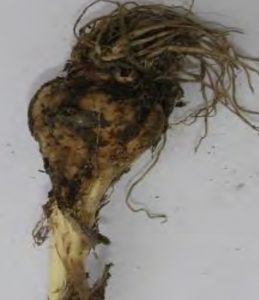
Two common species of bulb mites (Rhizoglyphus spp.) can cause damage in a number of Allium species and are sporadically found in garlic plantings. Bulb mites can survive on decaying vegetation in the field before it is completely decomposed. They have four pairs of short legs and are very small. Mites can reduce stands and slow plant vigor.
Bulb mites tend to feed on the basal plate. Their presence is often an indicator of another problem. Garlic bulbs damaged with another pathogen may predispose the bulb to further decay by mites. Pathogen damage may become a feeding site for mites and likewise mite feeding may create sites for pathogen infection.
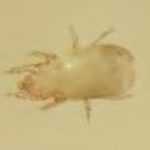
Bulb mites survive in organic matter, often remaining from the previous crop. A simple control measure for bulb mites is to allow the vegetation from the previous crop to break down before planting garlic.
Leek Moth

Leek moth (Acrolepiopsis assectella Zeller), is a relatively new insect pest found in Maine in 2017 and is not yet widespread in the state. Garlic scapes and leaves are most commonly fed on by leek moth larvae. Garlic yields can be diminished by heavy feeding on leaves. Damage in the field can be managed best by using floating row covers as leek moths are difficult to manage with sprays due to the need for the preciseness of spray timing.

Garlic bulbs may fall prey to leek moth larval feeding just after harvest when they are most vulnerable. Where leek moths are present, dry garlic on drying racks in a single layer in shade-cloth-covered high tunnels, in a shed or barn. Cover bulbs with removed tops with light-duty floating row cover beneath and over bulbs to prevent egg-laying by leek moth adults or add screens to doorway and side entrances to prevent access by leek moths adults. Extra air circulation will be needed to hasten drying if using row covers on bulbs.
Wireworms
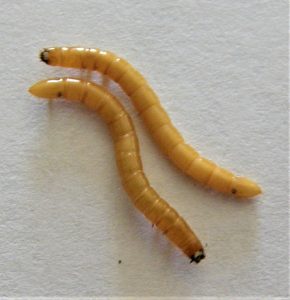
Wireworms (Coleoptera: Elateridae) are the larval form of the click beetle found in soil. Wireworms cause feeding damage to garlic that is largely cosmetic but such damage can be an entry point for pathogens both in the field and in storage. Once wireworms chew beneath the wrapper they are typically repulsed but may try feeding again on the same or other nearby bulbs.

Wireworms can be avoided by crop rotation and avoiding planting into newly-plowed turf.
